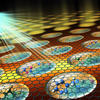Activities
Publications
Software
Tools and Instruments
Awards
News and Updates
Contacts
Group Leader
-
(301) 975-5418
Office Manager
-
(301) 975-2175
Group Safety Representative
-
(301) 975-6102















